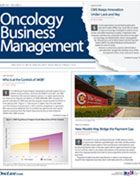Publication
Article
Special Issues
New Agents Make Inventory Management More Difficult and Precarious
Author(s):
Oral oncolytics can bring increased revenue to a practice but are inherently difficult to manage because of their high cost.
Josh Cox, PharmD, BCPS

Josh Cox, PharmD, BCPS
The rapidly growing use of oral oncolytics has provided a powerful incentive for independent practices to open in-house dispensaries. By dispensing these drugs, physicians can make sure patients are taking their medicine, monitor side effects, and recover some of the revenue no longer coming from chemotherapy, which has become less profitable in recent years. The Community Oncology Alliance (COA) counts at least 820 practices that have in-house dispensaries or pharmacies, many of which were started within the last several years (Figure).
This figure shows drug distribution shares, by percentage, of the major channels in oncology. Source: Genentech.
However, the transition to newer agents can lead to a number of challenges, many of them tied to the very high cost of the new generation of therapies. Practices may find themselves carrying more short-term debt while they wait for money from payers. They may also experience financial losses if coverage is denied after drugs are purchased or if medicines are spoiled because of refrigerator malfunctions and other mishaps. In addition, there are the daily battles with pharmacy benefit managers (PBMs), which steer members toward their own specialty pharmacies, reducing practices’ revenue opportunities and complicating oversight of patient compliance with treatment plans.
Careful management of pharmaceutical spending has always been necessary in order for a practice to manage its financial health. However, this has become even more critical now because targeted therapies can be so expensive. When new agents become available, payers may take up to 1 year to integrate them into their systems, leaving pharmacy managers waiting months for reimbursement. “I have seen a smaller practice get into a situation where it had major issues associated with cashflow because of denials or lag times in reimbursements for some of the expensive products that are out there,” said Josh Cox, PharmD, BCPS, director of pharmacy at Dayton Physicians Network, a Dayton, Ohio-based string of 8 oncology centers, and co-chair of the COA Community Oncology Pharmacy Association. “Those problems tend to be on the front side when a new drug is developed. Reimbursement and coverage tend to catch up, and the problem resolves itself.”
Even for established drugs, slow bill processing by payers can compound problems caused by eligibility determinations for expensive therapies, which can end up making denials even more costly, said Jeff Liticker, PharmD, oncology pharmacy manager at University of Texas Southwestern Medical Center in Dallas. “You could be into a treatment 3 or 4 cycles before you find out from the insurance company that you’re missing a piece of information or they’re now going to deny it because a marker wasn’t drawn or a marker didn’t fit with their guidelines,” he said. For example, a physician may obtain authorization to use pembrolizumab (Keytruda) for a patient whose PD-L1 levels satisfy the requirements described in the drug package insert, only to see payment denied because the payer finally reviewed the patient’s test data and found the levels did not meet the payer’s own higher cut point. “The costs can add up very quickly before you realize there is an issue,” Liticker said.
In addition to payer logistics, practices that dispense newer medicines must reckon with the high cost-sharing responsibilities common in commercial insurance policies. Plans that mandate bigger co-pays for today’s more expensive agents demand careful attention to collections and diligent financial counseling. “Years ago, if we didn’t collect the co-pay from some patients, it wasn’t that big a deal. Now, if we’re missing 2 or 3 patient co-pays, that quickly adds up,” Liticker said. However, many patients cannot afford a co-pay of several thousand dollars, forcing conscientious practices to work hard to obtain charitable funds. Christina Patterson, a physician assistant who manages the dispensary at Cancer Care Associates of York in Pennsylvania, said co-pay assistance from foundations seemed to dry up last summer, and money is particularly scarce for patients with certain common cancers. “There are so many men on Zytiga or Xtandi, and prostate funding is very, very low, if it’s even available. You can hardly ever find funding for colorectal cancer,” she said.
Refrigerators Must Be Insured Against Malfunction
When foundations do offer grants, it may take months of calling and resubmitting paperwork before payment arrives, during which time practices are carrying the drug debt. If assistance is ultimately denied, the practice takes a loss. “There have been times in our practice when the deadline to submit claims has been missed and then we are out of luck,” said Lisa Day, pharmacy technician at Ventura County Hematology Oncology Specialists in California. “We appreciate the programs so much and they are such a blessing to our patients in need, but the reimbursement process is not always smooth.” Liticker noted that manufacturers run programs that can help by pressing payers to approve reimbursements and, after denials, giving practices replacement drugs to make up for a loss. But he said that process can also take months and consume substantial staff time as requests move back and forth between multiple parties.Yet another type of loss amplified by the high cost of newer agents is spoilage, particularly of IV drugs that need to be refrigerated. Installing systems to prevent such losses adds up, as does responding to accidents. Liticker said a refrigerator thermostat once failed at his pharmacy, allowing the drugs to get too cold and forcing sta to quarantine the medicine while they evaluated whether it was usable. A staff member had to spend time conducting an inventory, checking temperature logs to see how long the drugs were too cold, and calling manufacturers for stability data, which was not always available. “First, you’re having to purchase new drugs immediately for the patients coming in that day,” Liticker said. “Second, can you get what was in the refrigerator replaced or do you have an insurance policy that will cover it? Insurance policies are becoming more common for refrigerators and freezers for pharmacies. There are some really unique concerns that we didn’t have before.”
Competition Adds to the Difficulty of Drug Management
Many drugs do not require refrigeration, but nearly all require a temperature-controlled environment that avoids extremes of cold or heat, Cox said. In addition to insurance, his practice has purchased expensive temperature-tracking software and devices that send out real-time alerts when refrigerators malfunction or temperatures in storage areas transgress desired limits, which has occurred a few times, he said. Some practices buy emergency generators. Accidents may be less of a problem at smaller practices because, for the most part, they purchase only preauthorized products, keeping their inventories minimal. Day recently reported having about $80,000 of medications on hand, while her practice spent $5.4 million on oral oncolytics alone last year. Total pharmaceutical spending at Patterson’s office was almost $8 million last year, but she rarely has more than $50,000 of unaccounted drugs on her shelves, she said.As practices have adapted to the practical requirements of operating pharmacies, they have also struggled with competition from incumbent distributors who are reluctant to share the cancer drug business. Most drug coverage in the United States is managed by a few large PBMs that also own retail or mail-order pharmacies to which they steer business. Day said her practice used to fill prescriptions for members of Tricare, the military coverage program, whose claims were handled by the nation’s largest PBM, Express Scripts. But in 2011, Express Scripts canceled its contract with the practice and pushed patients to switch to Accredo, its own specialty pharmaceutical provider, she said. Caremark, the PBM that owns CVS pharmacies, announced last year that it would no longer allow members to use physician dispensaries, a decision that was reversed after protests by COA and other groups.
Oncology practices are accustomed to making sure patients are taking their meds, adjusting doses as needed, and responding to side effects. The move to targeted therapies has put these goals in conflict with the larger pharmacy industry, which is focused more on delivering drugs efficiently than treating patients. Dispensary staffers complain bitterly about specialty pharmacies that try to monopolize prescription revenues and then fail to serve patients the way they would be by the practice. The staffers say the specialty pharmacies take much longer to fill prescriptions, sometimes fail to fill them, lose track of paperwork, are not assiduous about finding co-pay assistance, do not notify practices when a prescription is not picked up, and are not set up to manage toxicities.
“We’re dealing with a medication class that has some very unique properties, very unique toxicities, and unique monitoring parameters,” Liticker said. “Specialty pharmacies don’t have access to the patient medical record, don’t have ready access to the healthcare team to discuss issues, and often don’t even have access to the patient other than by telephone. When you’re forcing a patient into that scenario, it’s difficult to make a case that they could do it just as well as the clinic could.”
“Our profit margin on oral oncolytics is very, very low for the work we have to do for it. But I will take that low profit margin because clinically it makes sense,” Patterson said. “It’s far more difficult for me to manage a patient who’s getting their drug from a specialty pharmacy. If I can keep it in-house, even though it might only be a 1% to 2% profit margin, I’ll take it, because in the long run, it saves the practice time and money. My staff spends a lot more time on the phone with the specialty pharmacy and the patient making sure the drug got there.”


























%20(2)%201-Recovered-Recovered-Recovered-Recovered-Recovered-Recovered-Recovered-Recovered-Recovered-Recovered-Recovered-Recovered-Recovered-Recovered-Recovered-Recovered-Recovered.jpg?fit=crop&auto=format)
%20(2)%201-Recovered-Recovered-Recovered-Recovered-Recovered-Recovered-Recovered-Recovered-Recovered-Recovered-Recovered-Recovered-Recovered-Recovered-Recovered-Recovered-Recovered.jpg?fit=crop&auto=format)
